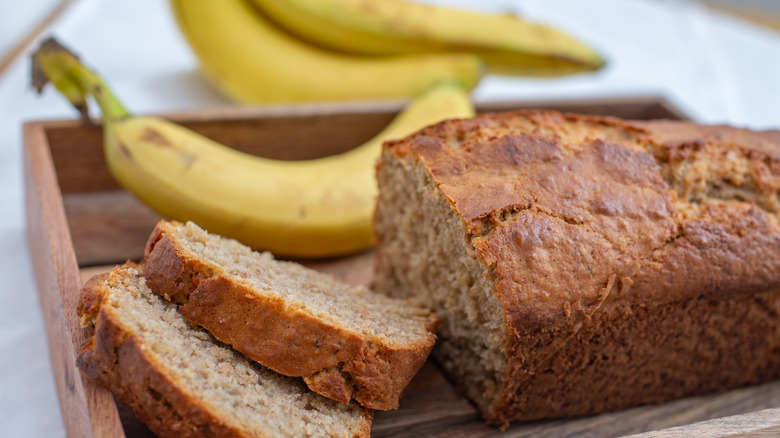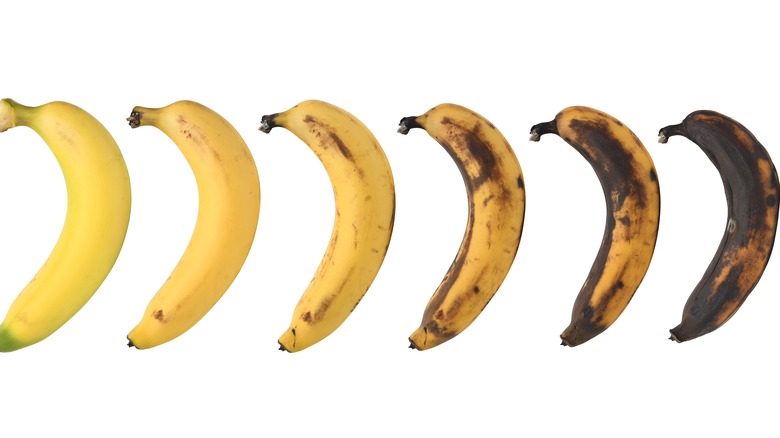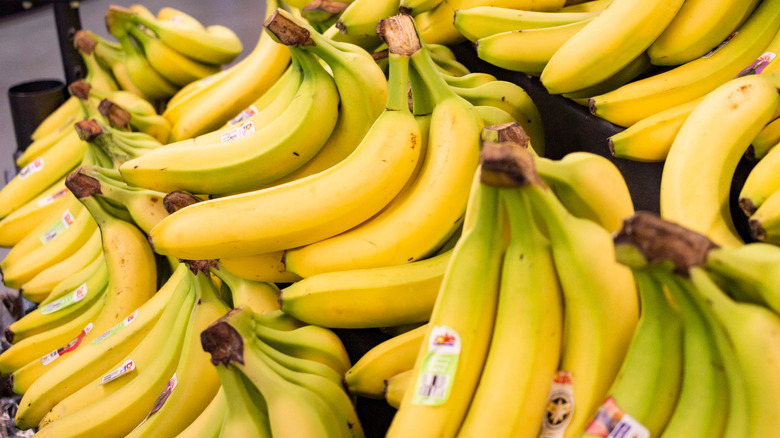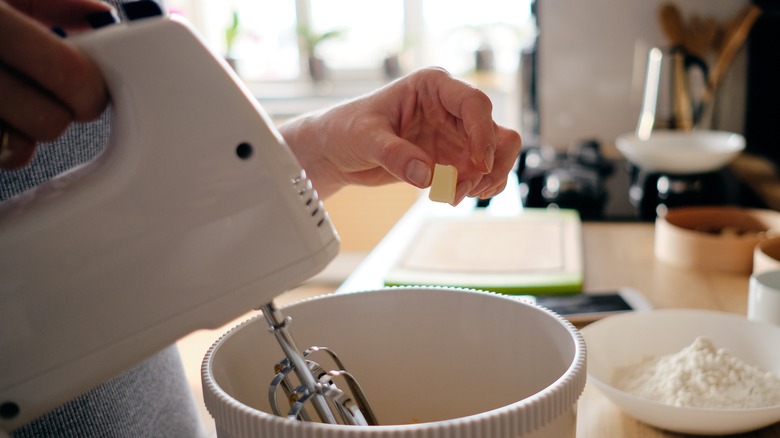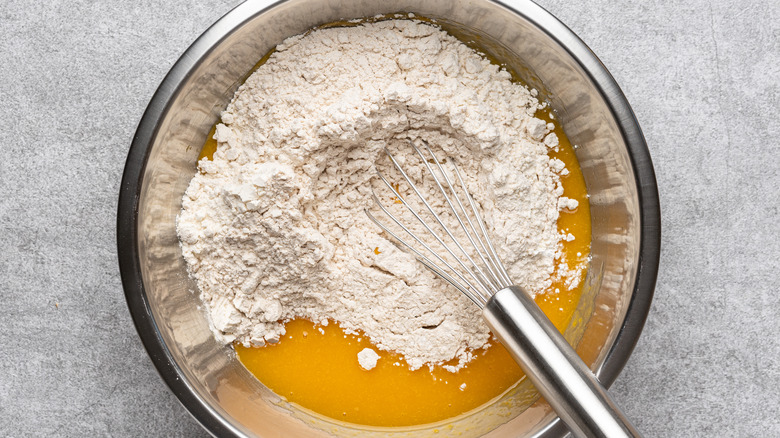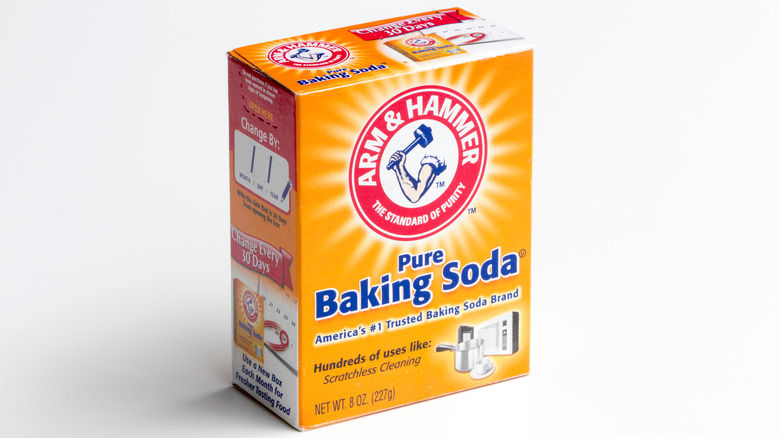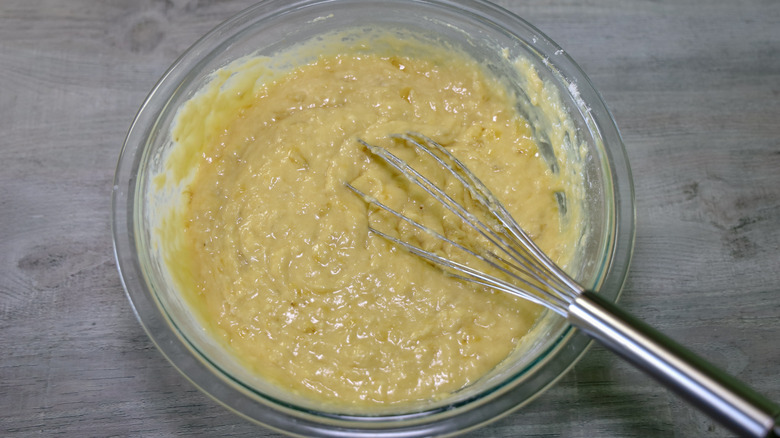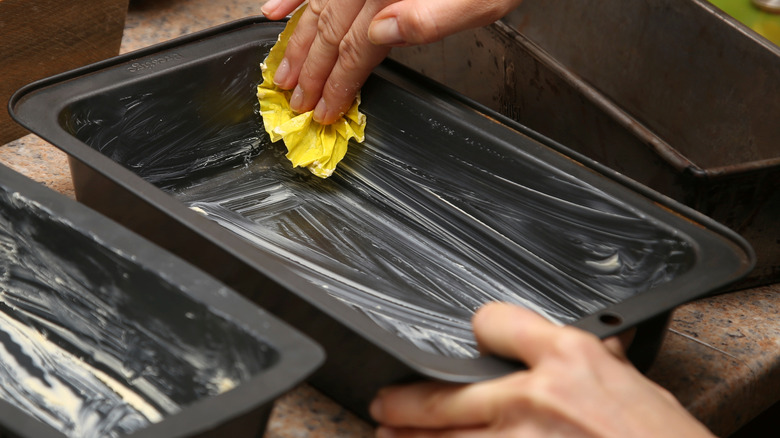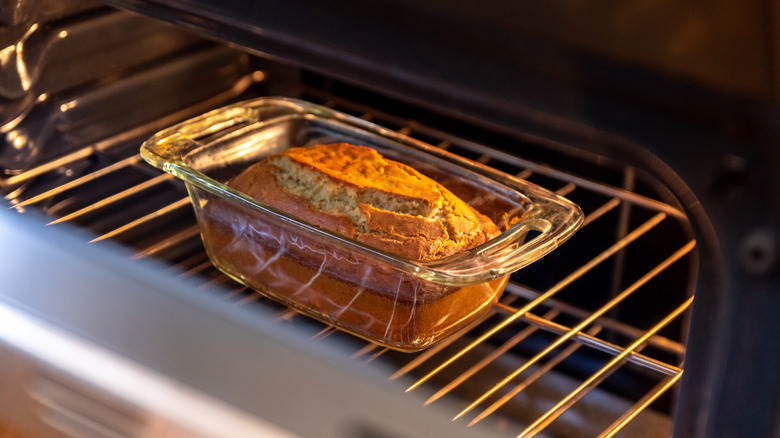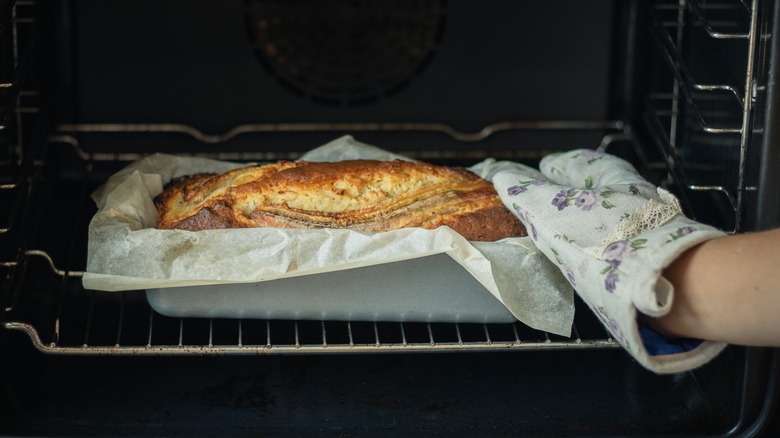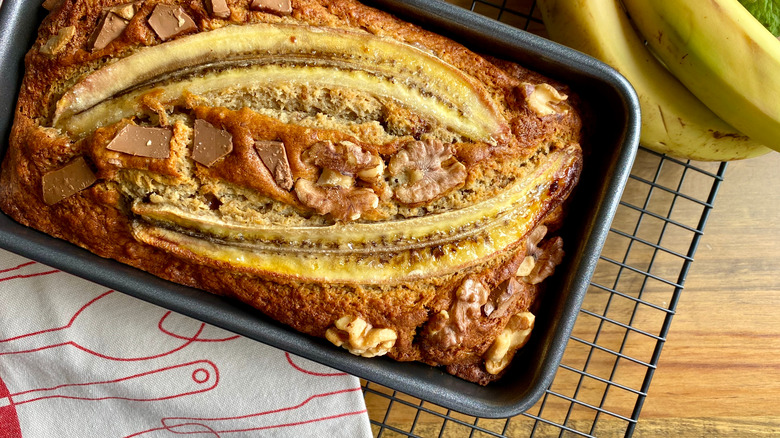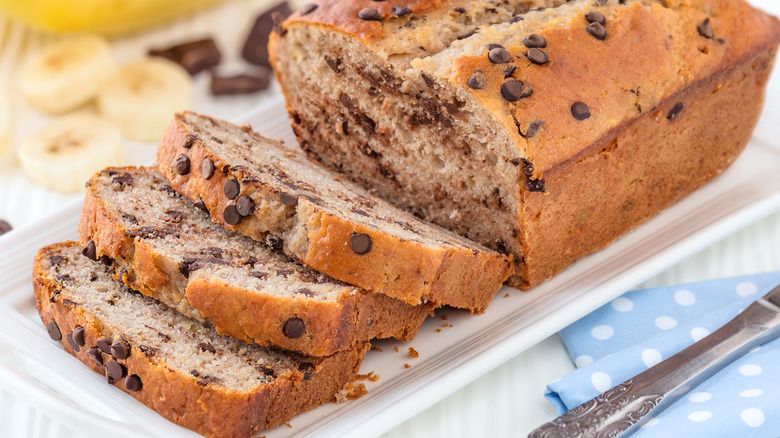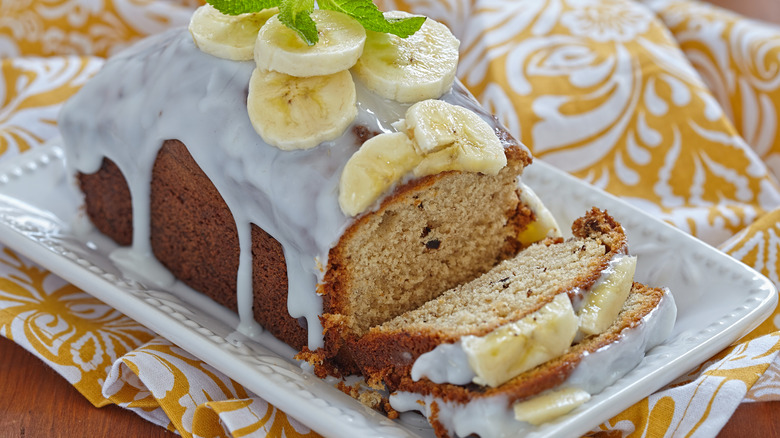Mistakes You Want To Avoid When Making Banana Bread
Almost everyone goes crazy for sweets, but there is only one dessert that is sure to make you go bananas — banana bread! This loaf has humble origins, but don't let that fool you. The taste of banana bread is anything but basic. The subtle flavor of a ripe banana, combined with generous portions of sugar and spice, makes banana bread one of the world's tastiest treats.
Banana bread has been a beloved dessert for decades. According to King Arthur Baking, the dish landed on American tables in the 1930s, when the Great Depression made the thought of tossing out browning bananas unthinkable. Nowadays, bananas are much less expensive and more available, but banana bread is still a great way to use fruit that has ripened past its prime.
Given its roots, you might imagine that banana bread is easy to make. In all likelihood, you could probably start making banana bread right now, using ingredients that you already have lying around your kitchen. Banana bread recipes can be among the most basic, though the exact difficulty depends on your chosen recipe. There are, of course, a staggering number of banana bread variations for you to choose from.
But before you embark on your baking journey, be warned — there are a lot of small mistakes you have to avoid in order to ensure that your banana bread is a-peel-ing.
1. Using under ripe bananas
Bananas can be purchased for next to nothing at any grocery store, but before you buy a green bushel, you should know that using appropriately ripe bananas is essential to making good banana bread.
Bananas ripen due to a hormone called ethylene gas, which sends a signal to the fruit to start producing more sugar, as NPR explains. If you regularly eat bananas, you know that the fruit transitions from green to bright yellow to spotted brown. But your preferred color for eating is not necessarily the right banana for baking. The proper baking banana should be dark brown, or even black, per Kitchen Parade. Fully ripe, or even slightly over ripe, bananas are ideal for baking, as that is when the banana is at its absolute sweetest.
Having a shriveled and fully browned or black peel is not an issue when making banana bread. According to Livestrong when your bananas have an unpleasant odor or develop mold that is when you should throw them out.
Better Homes & Gardens explains that if your bananas seem to be approaching over-ripe territory, you can freeze them whole in their peels. When you freeze bananas this way, they will continue to ripen and develop the brown peel that indicates your banana is ready for baking.
2. Using the wrong amount of bananas
Obviously, bananas are a pretty important ingredient in banana bread. They're half the name, after all. As such, it is absolutely essential that you use the right amount of bananas in your banana bread batter.
There is some leeway with the amount of banana (or lack thereof) you can use in a recipe before it becomes a problem. For inexperienced bakers this wiggle room can cause a lot of issues. There is no uniform number of bananas called for across banana bread recipes, and bananas can vary wildly in size. If you want to be sure that you're making a banana bread batter that will turn into a beautiful loaf, you want to find a recipe that measures bananas not individually, but by volume.
According to Taste of Home, a good rule of thumb to follow when comparing different forms of banana is that one banana is roughly the equivalent of ⅔ cup chopped banana, which is in turn equal to a ½ cup of mashed banana. Following this ratio will assure that you're using the right amount of fruit in your recipe.
3. Adding the wrong amount of flour to you banana bread batter
Flour is arguably the most important baking ingredient. It would be impossible to make delicious baked goods without it.
Flour is also very starchy. According to Baking Sense, these starches absorb the moisture in your batter while it bakes, which transforms it from a soupy mix into a solid structure.
Using the wrong amount of flour, in either direction, will lead to problems with your final product. If you don't want banana bread that is either a moist mess or a dry disaster, you need to take care when measuring out your flour.
There are several ways to ensure that you're using the right amount of flour. You can invest in a baking scale, which is the only way to guarantee you're using precise amounts, but if you're using a measuring cup, you should make sure your flour is fully fluffed, scoop it into the measuring cup with a spoon, then level it off with a knife, per Food Network Kitchen.
4. Not creaming together the butter and sugar
Butter and sugar manage to make their way into almost every baked good recipe. The two make a delicious (albeit calorie dense) pairing. One of the most important parts of making banana bread batter is how you handle these two ingredients. In this case by thoroughly creaming together the butter and sugar.
Unlike the other steps of the mixing process, creaming the butter and sugar doesn't simply mix two ingredients together. It aerates your banana bread batter, per Serious Eats. Essentially, this means that you are adding extra air into your batter, which leads to a lighter, fluffier loaf. Neglecting this step of the process will leave you with dense banana bread. Additionally, it's important that you use room-temperature butter, as butter that is too warm will be unable to hold the essential air pockets, as Bon Appétit explains.
Though it's possible to cream your butter and sugar by hand, it is easier to use a hand or stand mixer.
5. Mixing your banana bread ingredients together in the wrong order
Baking can be viewed as the most delicious branch of chemistry, and a recipe is essentially a chemical equation. When making banana bread, it's important to follow the formula to a tee if you want to make the perfect loaf.
According to Bigger Bolder Baking, you want to mix the dry and wet ingredients together separately. This guarantees that all the ingredients are incorporated with one another while reducing the risk of over mixing after wet and dry are combined. You might follow a recipe exactly, but failing to keep your wet and dry ingredients separate until the right moment could result in an unsuccessful bake.
In a standard banana bread recipe, you want to combine your dry ingredients, which generally include the butter/sugar mixture, bananas, eggs, and milk. Later, you will add this wet mix to the dry ingredients, which are usually flour, baking soda, salt, and cinnamon.
6. Using baking powder instead of baking soda
It's very easy to mix up baking powder and baking soda. They look the same and have very similar names, plus both products have essentially the same purpose. Without these miracle powders, your banana bread would very literally fall flat, as baking powder is what makes baked goods rise in the absence of yeast, per Smithsonian Magazine.
That's not where the similarities between the two products end. According to Medical News Today baking soda is simply sodium bicarbonate, a chemical that, when combined with an acid, creates carbon dioxide gas, which is what makes bread rise. Baking powder is also sodium bicarbonate, but it is pre-combined with an acid like cream of tartar. It also creates carbon dioxide during the baking process.
Mistaking baking powder for baking soda, while not as catastrophic a mistake in banana bread as it is in other baked goods, is ultimately still incorrect. Mashed bananas contain a fair bit of acid, as a study in Plant Physiology explains. As such, the additional acidic elements found in baking powder are not needed in banana bread batter.
7. Overmixing your banana bread batter
Once you have all your ingredients together in a mixing bowl, you might be tempted to whisk your batter with reckless abandon. There will be a sea of lumps and bumps in your banana bread, and you might want to make your batter perfectly smooth. You have to fight that urge. You can nail every step of the batter making process, perfectly measuring every ingredient and combining them in exactly the right order, and still ruin your banana bread in the last moments before you start baking.
According to Southern Living, when you over mix your banana bread batter, you overdevelop the gluten, which will make your loaf dense and chewy. Gluten is a wheat protein that helps baked goods retain their shape, per the Celiac Disease Foundation. In order to avoid overdeveloped gluten, you should exercise caution when incorporating your wet and dry ingredients, and stop mixing precisely when the dry ingredients have been fully moistened.
8. Forgetting to grease the baking pan
Banana bread loves sticking to the baking pan. This will make it difficult for you to remove your loaf from its pan after it's done baking. Your banana bread might end up missing chunks of its beautiful brown crust, or worse, it could wind up in pieces. To avoid this be sure to thoroughly grease your pan of choice, before you pour your batter.
Martha Stewart suggests several methods for greasing a baking pan. Of course, there are a wide variety of readily available cooking sprays. Simply aim your oil-based spray at the pan and apply an even coat to all of its sides. If you don't have a cooking spray, or are worried about the effects one will have on the flavor of your banana bread, you can take a stick of cold butter and rub it around the loaf pan.
Alternatively, if you want to avoid the extra grease, you could line your bread pan with parchment paper. Bon Appétit suggests that you allow some parchment paper to hang over the sides of your pan, so that when your banana bread has finished baking, you can grab hold of overhanging flaps and easily remove your loaf.
9. Baking your banana bread at the wrong temperature
If you can't stand the heat, get out of the kitchen. Without heat, your banana bread batter would never go from liquid to solid. Before you stick your bread in the oven, you should know that the exact temperature at which you cook your baked goods is essential. Most banana bread recipes suggest that you bake your loaf at 350 F for approximately one hour. However, the exact temperature may vary, so be sure to follow what your chosen recipe recommends.
One major cause of incorrect baking temperatures is neglecting to fully preheat your oven. While certain foods can be safely placed in the oven before it has reached the recommended temperature, baking doesn't allow for this type of willy-nilly oven use, according to Cooking Light. Putting your banana bread in an oven that has not yet reached your desired temperature will throw off the baking time, and ultimately result in a less-than-perfect loaf.
10. Taking your banana bread out of the oven before it's done baking
It can be difficult to tell exactly when your banana bread is finished cooking. Though you should always do your best to follow the recipe, any number of factors can affect baking times. For example, altitude can affect your bake, per King Arthur Baking. Therefore, it's important to test your banana bread's doneness before you remove it from the oven.
There are several ways to find out if your banana bread is done. According to the Washington Post, the only sure-fire method of assessing if your banana bread has finished baking is by taking its temperature. Banana bread, along with other quick breads, should measure in at about 200 F when it's completely baked.
If you don't have a thermometer, fear not. There is a less scientific method for assessing the status of your banana bread. Bon Appetít recommends the "toothpick test." Essentially, this method suggests that you take a toothpick, or another oven safe skewer, and insert it into the middle of your banana bread. If the toothpick comes out of your loaf without any batter adhering to it, your banana bread should be finished baking.
11. Not allowing your banana bread to cool before serving
Once you've removed your fully cooked banana bread from the oven and the sweet aroma of banana begins to fill your home, it will be very difficult to resist immediately slicing into the hot loaf. Don't do it! You must ignore your sweet tooth, at least for a little while.
Not allowing baked goods to fully cool before serving can ruin their integrity. According to Fine Cooking, when you bake bread, its starches soak up water and expand. Starches in bread fresh from the oven are still waterlogged, and as such, you need to allow bread to cool off so that some of the moisture can evaporate. While this isn't as important in quick breads as it is in regular bread, as the starches expand significantly less during the baking process, you definitely still want to allow your banana bread to cool before slicing it up.
You can guarantee that your banana bread has properly cooled off through a simple, multi-step process. First, after removing your bread from the oven, you should leave it in the baking pan for about 15 minutes. This waiting period will allow your loaf to cool and any steam inside to condense, making it easier to remove from the pan (via Livestrong). Then, carefully remove your banana bread from the pan and place it on a wire baking rack. Let the loaf cool completely before you dig in. Though these last few moments of waiting before you can eat your delicious banana bread will undoubtedly be torturous, allowing your loaf to achieve its perfect final form will be worth the wait.
12. Neglecting to add mix-ins to your banana bread
Some people prefer plain banana bread. While there's nothing inherently wrong with enjoying a simple loaf, there are many ways to spruce up your banana bread. Mix-ins can bring a whole new world of flavor to your dessert.
One of the most popular additions to banana bread is chocolate chips, which will add extra sweetness to your loaf, as well as a bitter element that rounds out its flavor. If you're feeling nutty, you could throw some walnuts into your banana bread, or even stir peanut butter into the batter itself, as Insider suggests. If chocolate and nuts sound a bit too rich for your palate, you could opt to include fruit in your recipe. Bananas and blueberries make for a great flavor pairing.
Ultimately, mix-ins aren't necessary to make delicious banana bread. However, once you've fully mastered the art of making banana bread, tossing in a little something extra is an easy way to make your loaf even more enticing.
13. Omitting a finishing glaze
We eat with our eyes long before the food ever reaches our stomachs. Banana bread smells incredible, and its rustic brown crust is visually appealing. However, a finishing glaze could be the thing that takes your loaf from good to great. If your banana bread is a well-constructed cabinet, you can think of the glaze like its lacquer coating.
According to Delishably, there are several reasons to glaze your baked goods. For starters, adding a glaze will make your banana bread prettier. As if that isn't enough reason, glaze will make your banana bread sweeter, and adding moisture in the form of a glaze to your loaf could make it last longer.
A basic glaze combines powdered sugar and a liquid, generally water or milk, per Domino Sugar. The thickness of your glaze depends on the amount of liquid added.
Like mix-ins, a finishing glaze is not an essential step in making delicious banana bread, but it's an easy way to boost your loaf's flavor profile. Glazes can be as thick or as thin as you want, and while a basic sugar glaze will make for a glorious coat, you can customize your glaze to add practically any flavor to your banana bread.
